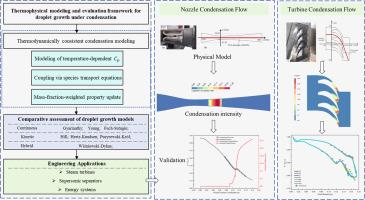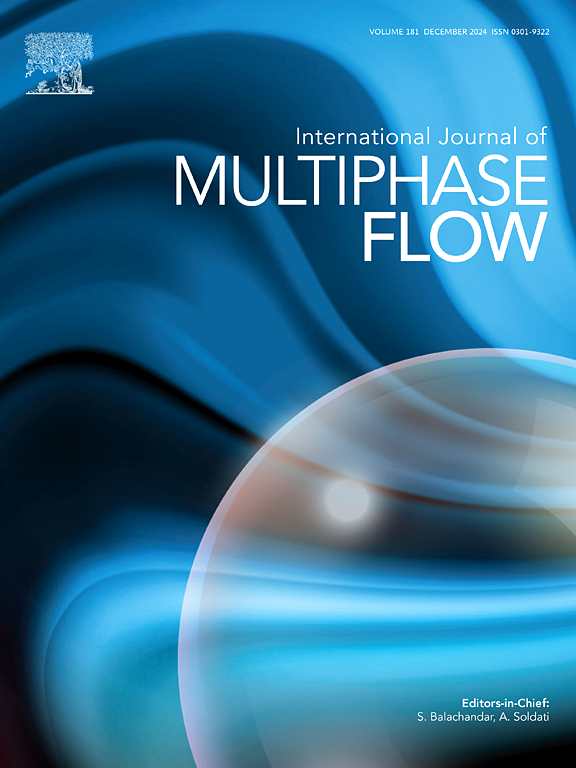含温度相关热物理耦合的非平衡冷凝液滴生长模型的比较研究
IF 3.8
2区 工程技术
Q1 MECHANICS
International Journal of Multiphase Flow
Pub Date : 2025-09-17
DOI:10.1016/j.ijmultiphaseflow.2025.105451
引用次数: 0
摘要
非平衡冷凝是一种复杂的多相现象,涉及高速流动条件下的气液相变、液滴成核和生长。界面传输过程的精确建模对于预测液滴尺寸分布、液体体积分数以及气液相之间的动量交换至关重要。然而,传统的模型通常假设气相比热容(Cp)恒定,而忽略了液相的贡献,导致能量守恒和热物性表示的系统误差。本研究提出了一个热力学一致的冷凝建模框架,该框架结合了蒸汽和液相的温度相关Cp值。热物理性质的耦合是通过物种输运方程实现的,可以在模拟过程中动态更新混合物的性质。利用该框架对超声速喷管和涡轮叶片叶栅两种典型构型下7种具有代表性的液滴生长模型进行了评价。加入温度相关的液相Cp后,预测的出口液质量分数和液滴半径分别降低了2.69%和3.59%,减轻了传统方法对冷凝强度的高估。在这些模型中,Gyarmathy和Hill公式的精度最高,对压力和液滴半径的平均相对误差分别小于0.65%和7%。相比之下,赫兹-克努森模型由于忽略了界面热阻而明显高估了生长。尽管在微观尺度上存在差异,但所有模型都趋于最终液体质量分数为6- 7%,表明在成核和生长之间取得了平衡。该框架提高了冷凝建模中的热力学一致性和预测准确性,支持相变预测至关重要的能源系统。本文章由计算机程序翻译,如有差异,请以英文原文为准。

Comparative study of droplet growth models for non-equilibrium condensation with temperature-dependent thermophysical coupling
Non-equilibrium condensation is a complex multiphase phenomenon involving vapor–liquid phase change, droplet nucleation, and growth under high-speed flow conditions. Accurate modeling of interfacial transport processes is essential for predicting droplet size distributions, liquid volume fractions, and momentum exchange between gas and liquid phases. However, conventional models typically assume a constant gas-phase specific heat capacity () and neglect the contribution of the liquid phase, leading to systematic errors in energy conservation and thermophysical property representation. This study presents a thermodynamically consistent condensation modeling framework that incorporates temperature-dependent values for both vapor and liquid phases. The coupling of thermophysical properties is achieved through species transport equations, enabling dynamic updates of mixture properties during simulation. The framework is used to evaluate seven representative droplet growth models under two canonical configurations: a supersonic nozzle and a turbine blade cascade. Including the temperature-dependent liquid-phase reduces the predicted outlet liquid mass fraction and droplet radius by 2.69 % and 3.59 %, respectively, mitigating the overestimation of condensation intensity in conventional approaches. Among the models, the Gyarmathy and Hill formulations exhibit the highest accuracy, yielding mean relative errors below 0.65 % for pressure and 7 % for droplet radius. In contrast, the Hertz–Knudsen model significantly overpredicts growth due to its neglect of interfacial thermal resistance. Despite microscale discrepancies, all models converge to a final liquid mass fraction of 6-7 %, indicating a balance between nucleation and growth. This framework improves thermodynamic consistency and predictive accuracy in condensation modeling, supporting energy systems where phase-change prediction is critical.
求助全文
通过发布文献求助,成功后即可免费获取论文全文。
去求助
来源期刊
CiteScore
7.30
自引率
10.50%
发文量
244
审稿时长
4 months
期刊介绍:
The International Journal of Multiphase Flow publishes analytical, numerical and experimental articles of lasting interest. The scope of the journal includes all aspects of mass, momentum and energy exchange phenomena among different phases such as occur in disperse flows, gas–liquid and liquid–liquid flows, flows in porous media, boiling, granular flows and others.
The journal publishes full papers, brief communications and conference announcements.

 求助内容:
求助内容: 应助结果提醒方式:
应助结果提醒方式:


